#wind related in the wheatfield
Text
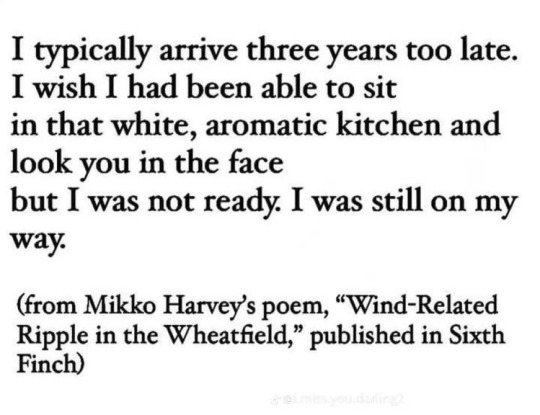



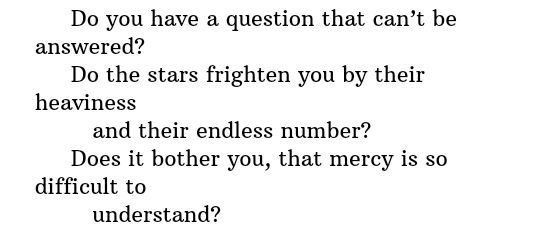


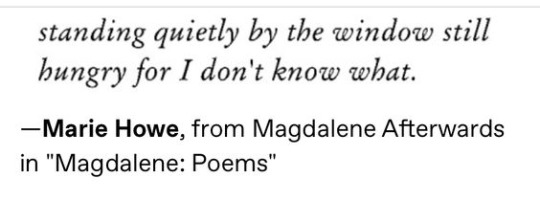
Mikko Harvey Wind-Related in the Wheatfield // Jonny Bolduc open question @jovialtorchlight // Cheryl Strayed Tiny Beautiful Things // @/mkpoet (instagram) // Mary Oliver Count the Roses // Phoebe Bridgers Waiting Room // Fyodor Dostoyevsky // Marie Howe Magdalene Afterwards; "Magdalene: Poems"
#idk what to call this#on self#on memory#on regret#web weave#web weaving#poetry parallels#poetry compilation#mikko harvey#wind related in the wheatfield#cheryl strayed#tiny beautiful things#mary oliver#count the roses#phoebe bridgers#waiting room#fyodor dostoevsky#marie howe#magdalene afterwards#writing#poem#spilled poetry#words#spilled thoughts#dark academia poetry#poetry#dark academia#dark academia quote#spilled ink
6K notes
·
View notes
Text
It is my intention to listen, but my hands
keep giggling while reminding me
I don’t get to be a human being
for very long, as if this were the punchline to a joke
whose first half I missed. I arrived too late.
I typically arrive about three years too late.
I wish I had been able to sit in that white,
aromatic kitchen and look you in the face,
but I was not ready. I was still on my way.
— Mikko Harvey, from "Wind-Related Ripple in the Wheatfield," Let the World Have You
#quote#mikko harvey#poetry#let the world have you#out of my collection#wind-related ripple in the wheatfield
468 notes
·
View notes
Text

WIND-RELATED RIPPLE IN THE WHEATFIELD
Mikko Harvey
445 notes
·
View notes
Text
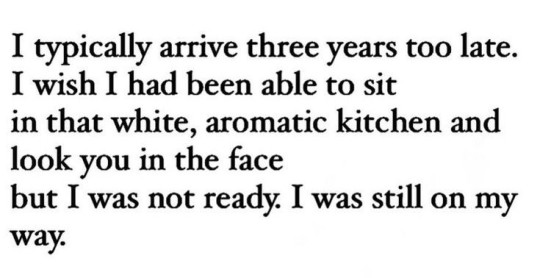
Mikko Harvey, "Wind-Related Ripple in the Wheatfield"
#writing#writers and poets#writerscommunity#writers on tumblr#creative writing#literature#writers#writer things#quotes#mikko harvey#wind-related ripple in the wheatfield#short poem#poems on tumblr#poems and poetry#poems and quotes#heartbreak#heartbreaking
14 notes
·
View notes
Text
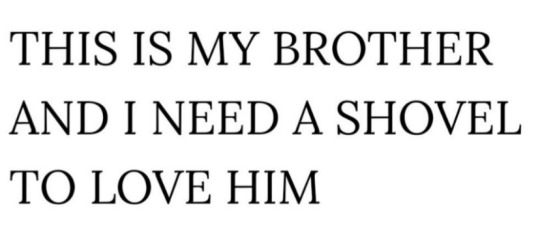



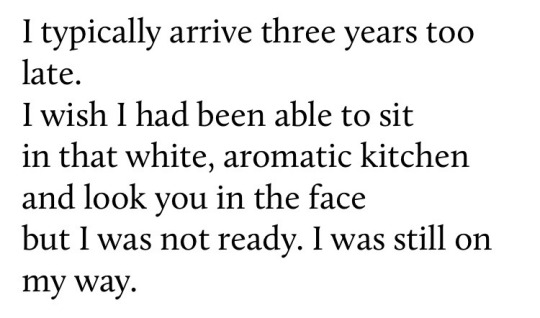
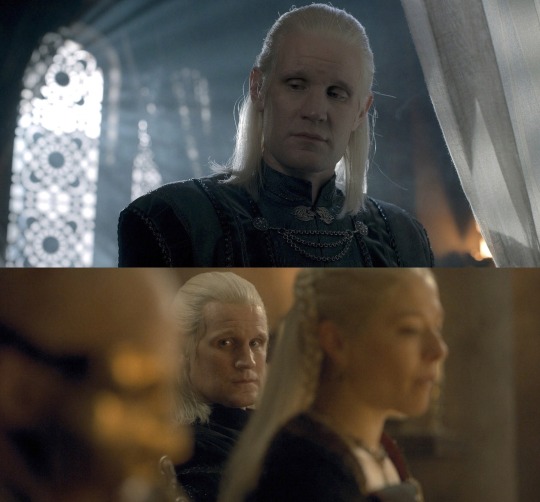


VISERYS & DAEMON
a brother named gethsemane, natalie diaz / the brothers karamazov, fyodor dostoevsky / wind-related ripple in the wheatfield, mikko harvey / he ain’t heavy, he's my brother, the hollies
#house of the dragon#hotd#daemon targeryan#viserys targaryen#viserys i targaryen#web weaving#hotdedit#asoifedit#king viserys#king viserys targaryen
219 notes
·
View notes
Text
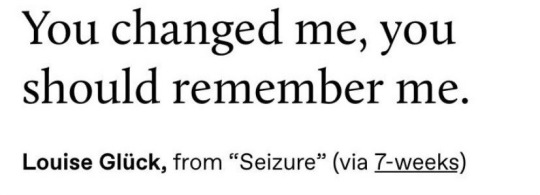

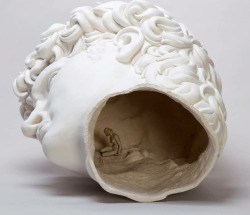

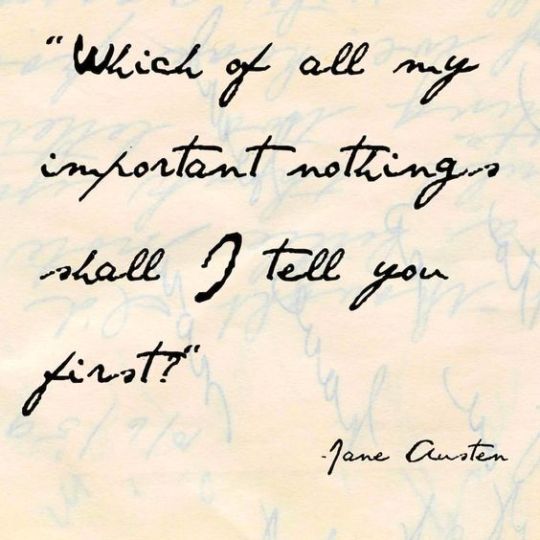



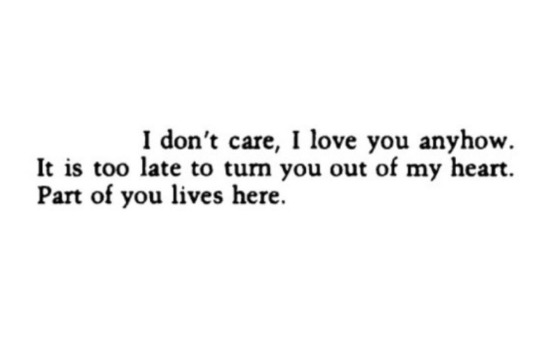

Louise Glück, Seizure
Andrea Salvatori, Testone
Mikko Harvey, Wind-Related in the Wheatfield
Jane Austen, Letters
Ruth Awad, In the gloaming, in the roiling night
Anne Sexton, A Self Portrait in Letters
Eden Robinson, Writing Prompts for the Broken-hearted
this is like a massive post because this is also our final farnauld playlist that's made of four parts. it's meant to tell their full story <3 can't say we really expect anyone to read through this or even check the songs but if someone wants a really weird playlist, u can listen to it here xx
ACT I: WE JUST PLAY ALONG, COME ON, COME ON
001. TRY TRY TRY --- RACHAEL SAGE. 002. I’M NOT CALLING YOU A LIAR --- FLORENCE + THE MACHINE. 003. COME ON --- WHITE LIES. 004. ON DIRECTING --- TEGAN & SARA. 005. POISON --- VAULTS. 006. EVERY BREATH YOU TAKE --- DENMARK + WINTER. 007. CANDLES --- DAUGHTER. 008. WICKED TEETH --- CIARAN LAVERY. 009. AFFECTION --- AMBER RUN.
this is the part where they get together. they're off-balance. he's playing his own game and she's trying to make everything work together. this is the first time cracks begin to form within the croÿ ranks. this part of the playlist is a mixture of songs that are fairly dark. the most notable lyrics can be found in ' poison ': " we both know you're sweet and blind / palm struck on the floor // won't you let me poison your heart ? ". isa posted this part of the playlist years ago and it's here x.
ACT II: THERE'S HISTORY IN A SCAR
010. PURGE --- ALLIE X. 011. WE USED TO LAUGH / 9 TO 9 --- FLORA CASH. 012. HYENA --- THE EDITORS. 013. LIFFEY --- PILLOW QUEENS. 014. SPIDERS --- THE EDITORS. 015. TIME COMES IN ROSES --- BESS ATWELL. 016. I'M NOT YOURS --- ANGUS & JULIA STONE. 017. PETRICHOR --- KEATON HENSON.
this would be the post-break up era. their numerous conversations and arnauld's relentless bullying. the wounds were raw, incredibly so and arnauld had a need to show her the mistake she had made by cutting him so. fanni on the other hand struggled between feeling proud of her decision and knowing she had let go of more than just a person she loved: it was the opportunity to build a life outside of her family. both of them tormented each other just by existing. it was difficult to hate someone you loved. it was difficult to despise someone you had known so well.
the sensitivity eventually made space for some sort of a relationship. they could hold conversations. they could blackmail each other and remind the other how deep their knowledge of the other went. the first two songs most certainly represent fanni and her struggles. in ' purge ' we get the lines: " you went anyway, but all of your chains / and ropes holding me stayed in place " and " every word you told me left such a rancid taste in my mouth / i can't purge you ". we had ' we used to laugh / 9 to 9 " on every edit back in 2019. it was such a perfect song for them at that time.
" you said i won't ever leave your side
no one else is worth my while
no one else is worth my while
were you like that all the time ?
did you repeat this from 9 to 9 ?
never come back
never come back
you put a hole in and opened up my heart
put me down in my darkest dark
we used to laugh
we used to laugh "
then we have the editors songs that got chosen for the darkness. arnauld was doing his best to get fanni to beg for forgiveness. the bitterness was felt constantly. ' liffey ' on the other hand is arnauld's realization that he's not in charge of himself or the situation. he is absolutely ruined and she holds far too much power — it's not just arnauld who knows secrets and ways to manipulate the other, fanni's just as capable !
ACT III: WHEN I LOSE MY HEAD, I LOSE MY SPINE
018. COOL ABOUT IT --- BOYGENIUS. 019. LUCKY FOR YOU --- NOVO AMOR, GIA MARGARET. 020. I MISS YOU, I'M SORRY --- GRACIE ABRAMS. 021. DAYDREAMS --- EXES. 022. SEABED --- NANNA. 023. LATE NIGHT TALKS --- DEPORTEES. 024. HEAVENLY --- CIGARETTES AFTER SEX 025. HOPELESS WANDERER --- MUMFORD & SONS. 026. THAT'S WHEN ( TV ) --- TAYLOR SWIFT.
this part is about their healing journey. when the mind games stopped. when it was just two people. a fairly wholesome part in their story. they had affection for one another and perhaps for the first time they did not have some role to play. it was just friendship ( or at least as platonic a relationship as it could be between these two ). some codependency issues existed, of course. fanni needed a shoulder. arnauld liked being needed by her. ' late night talks ' is possibly the most spot on song in part iii. in it we get: " the phone rings / in the middle of the night / i can tell you're upset / i'm here / and i'm ready to work ". ' seabed ' is incredibly touching too and probably our favourite track. it's a good peek into fanni's fragile state of mind. " and you caught me off guard, and / i was never lonely / but now i'm feeling like an only child / let me sink into you arms / you're the ocean floor / i guess i just needed that ". the songs in this section are vulnerable and beautiful. ' lucky for you ' has a line that made it earn its spot: " and i'm not what i thought i would be without you ".
ACT IV: I'VE OUTGROWN THE PAST
027. I WANT YOU --- MO. 028. YOU'RE SO COOL --- NICOLE DOLLANGANGER. 029. LIGHTS CHANGING COLOR --- STARS. 030. LIVING ROOM, NY --- LAURA STEVENSON. 031. SIGNAL FIRE --- SNOW PATROL. 032. BLOODCLOT / ANDVAKA --- NANNA. 033. CRACK THE SHUTTERS --- SNOW PATROL. 033. SEND FOR ME --- THE NATIONAL. 034. THIS LAND IS MINE --- DIDO. 035. THIS LOVE (TV) --- TAYLOR SWIFT. 036. I WILL FOLLOW YOU INTO THE DARK --- MIYA FOLICK. 037. COSMIC LOVE --- FLORENCE + THE MACHINE. 038. SHALLOWS --- DAUGHTER.
this is the happily-ever-after part because they've been so sad for such a long time. we seriously considered not having them end up together but they deserve each other <3 <3 this section has love songs but we managed to sprinkle a few darker ones too because fanni and arnauld have never been simple and sweet. ' this love ' is probably the stand out song, it seems so fitting ! i mean c'mon: " this love is alive back from the dead / these hands had to let it go free, and / this love came back to me ". not to make things too cheesy though we have ' lights changing color ', which is by no means a negative song but it's more about staying out of one's head and, well, happy ! " when you find that the ones that keep you lifted / love them 'cause they keep you out of your head / they keep you out of your head / they keep you steady ". the songs are quite mellow and sound pretty fragile in a sense, save for a few tracks.
the last two songs are more abstract. ' cosmic love ' is possibly one of the most beautiful songs on this playlist and to ever exist. i can see their devotion to each other growing into something blinding. this maybe relates to fanni more, she seems more likely to make love and her life with arnauld the only thing she surrounds herself with. there's just that and nothing else. but... arnauld is not too far from this state. he'll be able to reason with himself and he has his duties, but considering how recklessly he acts all things fanni... " i took the stars from my eyes and then i made a map / and knew that somehow i could find my way back / then i heard your heart beating, you were in the darkness too / so i stayed in the darkness with you... "
the playlist ends with ' shallows ' because it was so serene. serene and hauntingly beautiful. it's a sister-song to ' i will follow you into the dark '. when one parts from this world, will the other come find them when it's time ?
12 notes
·
View notes
Text

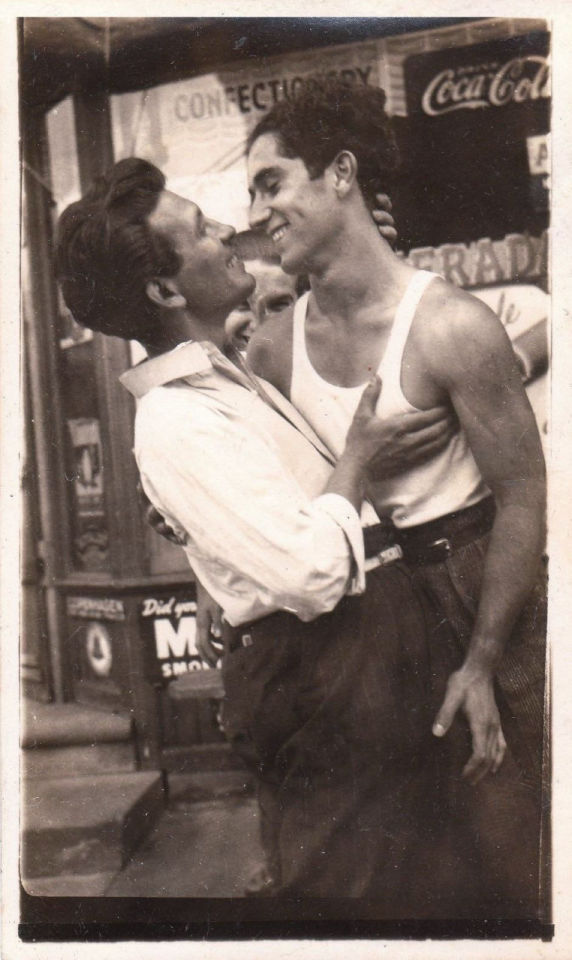


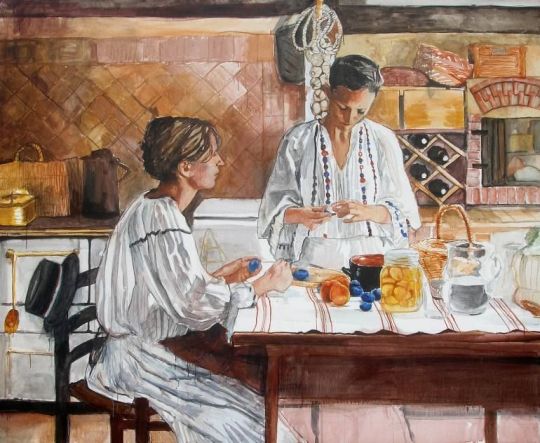

e.m. forster / unknown / leonard freed / james baldwin, giovanni's room / helena janecic, young slavonian women / mikko harvey, wind-related ripple in the wheatfield
209 notes
·
View notes
Text
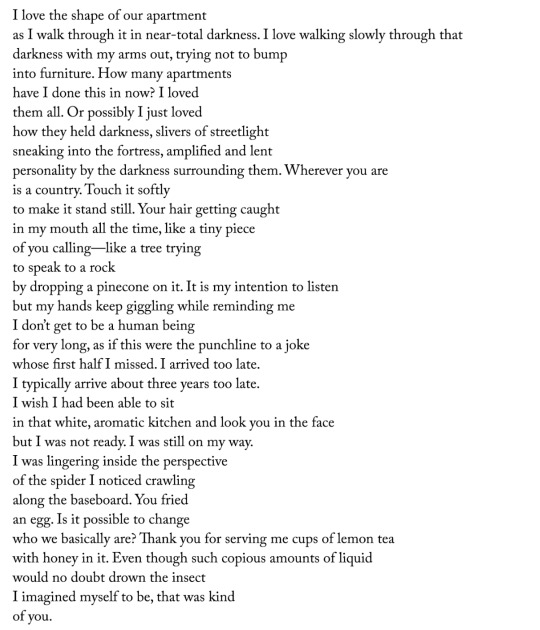
wind-related ripple in the wheatfield by Mikko Harvey
4 notes
·
View notes
Text
I wish I had been able to sit
in that white, aromatic kitchen and look you in the face
but I was not ready. I was still on my way.
I was lingering inside the perspective
of the spider I noticed crawling
along the baseboard. You fried
an egg. Is it possible to change
who we basically are? Thank you for serving me cups of lemon tea
with honey in it. Even though such copious amounts of liquid
would no doubt drown the insect
I imagined myself to be, that was kind
of you.
— Mikko Harvey, from “Wind-Related Ripple in the Wheatfield”
709 notes
·
View notes
Text








Blair + prose & poetry 2/3
Clementine von Radics, “Sweet the Sound” / 3.17 "Inglorious Bassterds" / Maya C. Popa, "Dear Life" / Iris Murdoch, The Philosopher’s Pupil / Siaara Freeman, “Erasure Poem From Bone Thugs N Harmony’s Crossroads” / Leila Chatti, "Echo (All She Lost She Lost)" / Sarah Kay, "The Type" / Mikko Harvey, "Wind-Related Ripple in the Wheatfield"
#blair waldorf#gossip girl#web weaving#blair texts#~fell from the pedestal right down the rabbit hole edition~#actually had to physically restrain myself from not posting all of The Type#if you've never read it/listened to it please treat yourself and do#jessica does web weaving#source: home of the nutty#*
75 notes
·
View notes
Text
Headcanon: the mind’s structure and the concept of a Side’s “room”
Hi.
This post is entirely based one the last asks I got, in which dear sweet anon asked me: "How do you think the rooms of the other sides will look like?"
And so here I am, talking about my own headcanons. Was the ask just an excuse to write this post? Yes.
Of course I don’t pretend to talk about possible canonical rooms Thomas can make in real life (I already wrote a post about that). This one is entirely based on the ideas I’m developing through my fanfictions.
____________________________
The mind’s structure
One of the most famous images associated with the mind and how it’s structured is the iceberg one.
For the people who have never seen it, here’s a sample image:
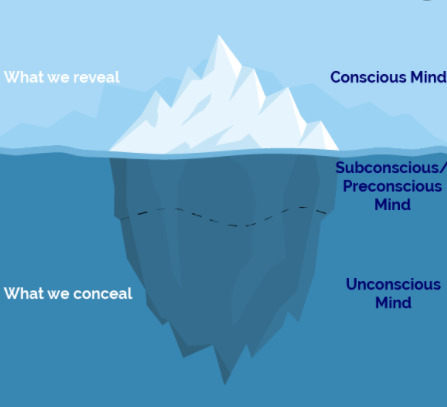
As you can see, it’s theorized the mind can be roughly divided into three parts:
Conscious mind, which includes all of the things that you’re actively aware of: thoughts, perceptions of the world, etc.
Subconscious/preconscious mind, which includes all of the things that you could potentially pull into conscious awareness. It’s a sort of “filter”, that controls what is allowed to be part of the conscious.
Unconscious mind, which includes everything that is outside of our conscious awareness: hidden feelings, thoughts, urges, all that’s unacceptable and/or unpleasant.
Having said that, I think you already have an idea about where some rooms might be located.
But that’s not all. This is the overall structure of the mind. The mind itself is made of a series of layers: the higher ones are part of the conscious mind, the central ones are part of the subconscious and the lower ones are part of the unconscious.
The proportions are the same as the iceberg image: few planes on top, a whole lot of planes at the bottom.
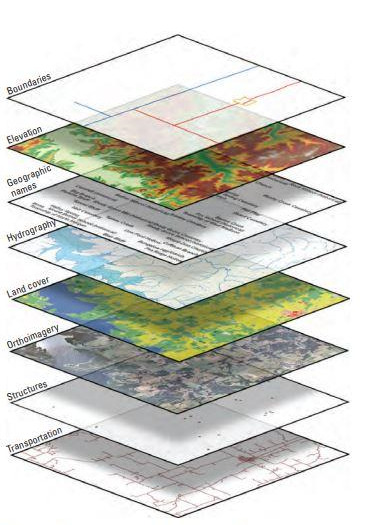
This is the only image I found that was close enough to how I imagine the planes are. Every plane has its own ecosystem: it can be a forest, a wheatfield, a beach, an island in the middle of an ocean, Thomas’ neighborhood, his house. The more Thomas grows, the more planes appear in his mind and their borders aren’t always the same: some planes might seem endlessly big, others as small as a single house.
And of course the planes aren’t flat surfaces either: they’re three-dimensional and you can move inside them, just like you can move in our world.
But if a Side wants to move from one plane to a lower one, then they sink. While when they move from a lower plane to a higher one, they rise up.
Yes, it’s a reference from Nostalgia part 2:
[Virgil]: -pops up in the same way as the others- Whoa. That was new for me. I've never done that whole... rising up thing. How do you guys do that every episode? I'm so lightheaded.
And what do you do when you rise up a lot? You end up on the reality plane. Where Thomas is, were we all live. And where Sides appears, when Thomas calls for them.
Okay, everything good?
Very nice. Now you know more than the actual Sides.
The Sides themselves doesn’t know how the mind is structured. They know there are different places and some are a bit lower than others (because they sink a lot, before reaching them), but they have no idea these places are divided into planes and they have no idea how many planes are actually in the mind. They don’t even know where exactly are their own rooms, just that some are “higher” and "lower” than others. And why should they know? They don’t need this information, to better do their job.
There’s only one Side who perfectly knows how many levels are in the mind - and yes, he needs to know for his job - and this Side is Janus.
____________________________
The rooms
A room is just one of the mind’s many layers that one Side chooses as his own.
This choice isn’t casual: the planes appear within the mind, the same mind who created the Sides. So, among a lot of other planes, there’s also one specifically made for each Side.
The room is the only place where a Side has full control over everything. While the other planes are always the same and can’t be changed by no one (except for the two Creativities, whose power “leaks” into the levels above and below their own room), a room allows full creative control to their owner. A Side can change the place, shrink it, expand it.
And this explains why Patton’s room looks like Thomas’ house: because he actively chose to make his own room look like a place dear to Thomas, associated with memories and childhood.
This also explains why Virgil chose to make his room look like Thomas’ as well: he’s Anxiety, he fears changes. The bubble is secure, the bubble is everything. And Thomas’ own house is the perfect bubble to keep his anxiety at bay.
So, let’s see each room a bit closer:
__________________
1. Logan’s room: tip of the iceberg
Logan’s room is almost at the top of the mind, the closer to reality. Again, for obvious reasons: logic is the most conscious, rational part of the mind, the less influenced by the subconscious and the unconscious.
Since I’m a sucker for the contrast between logic and powerful nature, Logan’s room is a lighthouse that stands on rocks and is surrounded by the ocean. On top of the lighthouse there’s a cozy, circular living room surrounded by glass windows. There are nice couches, tables, soft rugs and globes of yellow, warm lights all around. No need for a bookcase: the book Logan wants to read is just on the table. He needs a computer? Here it is, it just appeared on the table.
When everything is fine, the ocean is calm and peaceful, day and night alternate as always, the sky is clear and, while the outside reminds of a fresh, summer morning, the living room looks more like a warm, soft winter home.
When Logan isn’t fine, everything changes. The storm takes control of the whole room: the waves crash against the lighthouse, there are thunders and lightning. There’s no more day/night cycle, the storm can go on for days. It’s impossible to stay outside. Inside, everything turns dark.
The place doesn’t welcome you anymore, even if its owner would never send you away. But, if you’re clever, it’s better to leave.
__________________
2. Roman’s room: blooming creativity
Considering Roman is a more controlled Creativity compared to Remus, his room is located way higher than expected from a creative force like him.
Roman’s room is a realm made of ideas. But, like, literally. Everything is made of ideas. And the stronger the idea is, the most real the thing looks like.
For example: if Roman wants to make a fruit tree, the clearer and more vivid his idea of said tree is, the better the tree will be: it will have knots in the wood, ants walking on its branches, flowers will bloom and their petals will fall to let the fruit grow.
And this applies to EVERYTHING. Trees, houses, rivers, hills, mountains, clouds, sun and moon, the day/night cycle, every atmospheric phenomenon and every single grass blade.
Roman’s room is endless. He walks inside it, but he has never seen the end. When he needs a place to stay, a new house appears. When he’s tired, the sun goes down.
His own creativity stems and takes the shape of trees, flowers, fruits. So when Roman eats a fruit, a new idea is born in his mind. When a gust of wind hits him, a new idea appears. And while he walks, he keeps developing the idea, adding details and information he literally takes by the wind, the grass and everything his room has to offer.
In other words: his room is a stream of ideas that constantly changes, while still keeping the same aspect. His room is always different, because he always walks, but it still looks like a natural landscape. There is continuity with how it looked like the day before.
Unlike Remus’ room.
__________________
3. Patton’s room: first of the subconscious
I wasn’t so sure where to put Patton, then I found out memories are located in the subconscious part of the mind and, well, it made a lot of sense.
Patton is Thomas’ emotions, memories, and morality. This last aspect is very close to the conscious mind, sure, but emotions and memories are both part of the subconscious. And, since I think Patton’s first job was related to Thomas’ emotions, his room could very well be located in the high levels of the subconscious.
Patton’s room takes the appearance of Thomas’ house. Sometimes it’s his own house, sometimes it’s his childhood house. And we saw how it was inside: filled with memories, glittering aura and so on.
This is where Patton sleeps and rests, but that’s not the only place he visits. Patton frequently explores other planes of the subconscious and the conscious.
Why? He’s not sure either. He just wants to do it. He doesn’t know, but he’s acting as a sub-controller of the mind, by double checking everything that goes from unconscious to conscious and vice versa.
__________________
4. Janus’ room: an always shifting vault
Janus knows how many levels are in the mind, their position, what they have inside and, in general, everything that happens in every level - he needs to check every information that goes from unconscious to conscious, after all.
But he doesn’t know where his room actually is. Because his room is the only one that shifts.
Its general location is the low-subconscious, but Janus’ room can actually be anywhere he needs it most - and yes, this is useful for his job: if he needs to move from his room to the low unconscious, he can’t waste time sinking like all other Sides: his room shifts and, with one small sink, he’s already where he has to be.
This also makes it incredibly difficult for other Sides to actually find his room and visit him. But that’s also good, because other Sides can’t spend too much time in his room anyway.
Why? Security reasons.
Let’s take a step back. Janus is self-preservation. In other words: that force that keeps you alive and protects you, both mentally and physically.
This implies the mind itself isn’t a safe place either - after all, the unconscious is where everything dangerous is stored. And, since Janus is the one who has to keep what Thomas doesn’t like/wants to know at bay, that means he’s the first controller of the unconscious (hence the two titles of guardian and gatekeeper) and of the exchange of information that exists among all levels.
In addition to that, there’s the pull of the unconscious. Because we all experience it, once in a lifetime. We are all attracted by what we deeply hide into ourselves - something we’re not conscious of, thoughts we might think we do not have at all. We never truly fall down this spiral (that would lead to dementia, delirium and so on), because our own mind pushes us back, bringing us back to reason.
For Thomas, this force that opposes the pull of the unconscious and brings you back to reason is Janus. And, as you can figure out, it’s an incredibly powerful force. A force that never sleeps, is never tired, always vigilant, always aware.
So, what happens when Janus needs to rest? He can’t do it anywhere, because a weak self-preservation is all the unconscious needs in order to take control.
This is where his room comes into play. His room is the only place where Janus can actually rest and allow himself to be weak. His room is like a vault, secured from the mind’s influence and from anything else.
Also, since he has full control over it, he can decide when he needs to disappear. A Side is looking for him but he needs more time to rest? His room shifts multiple times, so no one can find him. He’s fine? He let the other Side find him on the first try.
Still, other Sides can’t spend more than 5 minutes into his room. His room shifts and is more secure than any other, sure, but it’s also connected to everything. Even if he’s in his room, Janus still knows what happens everywhere. And a Side who’s not self-preservation might break for the amount of information that “oozes” from the room itself.
__________________
5. Virgil’s room: a peaceful place in the middle of the unconscious
Just like Patton, Virgil chooses his room to look like Thomas’ house and, in general, all places Thomas feels more at ease.
However, it’s still a room located in the unconscious - and this is a very dangerous place, especially for Sides who live in the conscious/high subconscious. And it’s also Anxiety’s room, so the room itself is full of the influence of its owner.
Hence why, after a while, all Core Sides started to feel the influence of Virgil’s place during AA-part 2.
__________________
6. Remus’ room: bursting creativity
Remus’ room is ever changing: Remus wants a field? There’s a field. He wants an ocean? Here’s the ocean. He wants to live inside a whale? The room is now a whale.
Just like Roman’s room, everything is made of his own creativity. But, unlike Roman’s room, who solidifies his creative power into a constant, coherent landscape, Remus’ landscape always changes, glitches, switches. The room is never the same, there’s no day/night cycle, nor coherent phenomenon: It could snow with 30 °C, it could rain with no clouds. Remus’ creative potential is so strong, it actually ends up influencing the planes above and below his own - just like Roman does up in the consciousness.
And here’s the most important thing: Remus’ room has direct contact with Roman’s. Despite being separated by a huge number of layers and with the subconscious acting as a barrier between them, their rooms are able to communicate. Remus can “plant” his ideas in his room and, like roots, these ideas are able to reach Roman’s room and bloom directly inside it, without touching any other layer in the middle.
That explains why Remus’ influence is able to reach Roman and how Remus’ idea can be literally picked by Roman, “ate” and processed.
__________________
The lowest level
What’s at the bottom of the mind? No one knows. No one could reach the bottom. The only one who can go deep down without going insane or losing himself is Janus, but even self-preservation isn’t able to see what the mind hides at the bottom of itself.
The lowest place Janus can reach is where there are what I called “The Faint Ones”.
The Faint Ones aren’t a Side, nor multiple Sides. They’re an indistinct agglomeration of ideas, concepts and things that will never become Sides. All the Faint Ones want is to surge to the top and take control. But, since the mind is the one in charge, all it does is pushing these forces deep down.
However, the Faint Ones can still call, ask and pray to be freed and their calls can lure the Sides down, just like marine predators do.
The Sides from the unconscious can hear these calls but, since they live in the unconscious, over time they developed some resistance. Still, they can’t venture too deep into the mind (and, with a guardian like Janus, they do not). Remus can hear the calls, but they’re more like a background noise. Virgil just hears faint voices.
On the other hand, Patton, Roman and Logan can’t hear anything from the conscious and subconscious. But if they go too deep into the mind, they start hearing the calls and they are way more hypnotic for them. (That’s also why Janus knows everything that happens inside the mind: to be sure no one goes below a certain point)
Speaking of Janus, of course he’s able to hear the voices and the more he goes down, the more he can recognize their words. Still, the Faint Ones’ calls do not act as a lure for him, no matter how down he can go. He can even face them and still be in complete control.
Because yes, he’s the only one who has ever seen the Faint Ones and knows what they look like.
_______________________________
TAGLIST:
@willpowerwisps @royalprinceroman @reesiereads @mudpuddlenl @shelby-711 @allmycrushesaredead @aquatedia @sweetkirbi @whatishappeningrightnow @effortiswhatmatters @atlasistryingherbest @bella-in-a-bag @doydoune @miasheer @forever-third-wheeling @mishanthropist @corndot @payte @mcang3l @geekyapollokid @kawaiipotatuh @hypnossanders @idontreallyknow24 @imcrushedbyarainbow @simplyapannightmare @patton-cake @hereissananxiousmess @purplebronzeandblue @cynicalandsarcastic @empressserelene @dubstepbranch @chara-073 @lost-in-thought-20 @arobohamster
@riseofthewerewolf @frog-candy-bee @bosspotato01 @rosesandlove44 @methaley @sololad @firey-alex @sashootkahoot @chewy-rubies @groaaaaan @croftergamer @misty-the-girlflux-mess @thedevilseyes @arya-skywalker @csi-baker-street-babes @queen-of-all-things-snuggly
@virgildarknessdementiaravenway @mishanthropist @dracayd-universe @unknown-artworks @lonelyfangirl453 @starlightnyx @alienvamp-hesitantflowerface @stubbornness-and-spite @alittletoo-extra @averykedavra @iloveeverytjing123 @bookedforevermore @joyrose-fandomer @anachronismes @the-cloud-14 @mihaela-tbg @igonnatalknothing
@thatoneloudowl @grayson-22 @softangryfuckingdepressed @theotherella @boopypasta @nevenastark @varthandi @floofyconfusednerd @nothing-worth-mentioning @mikalya12 @roses-bubbles @cuter-on-the-inside @coldbookworm @orchidstanslogan @snixxxsmythe @frog-candy-bee @holleratyour-buoyancy @alexowlndra @fadingbagelbananapatrol @our-bloody-mari666 @cxsmospooks @riverraysong @sanity-whosshe-neverheardofher @charmingcritter @analogical-mess
#sanders sides#analysis#Headcanon#my fanfiction#thomas sanders#patton sanders#logan sanders#roman sanders#virgil sanders#janus sanders#remus sanders#sanders sides theory#it's so satisfying to put everything down#but it also required a lot more words#it was shorter in my mind
178 notes
·
View notes
Text
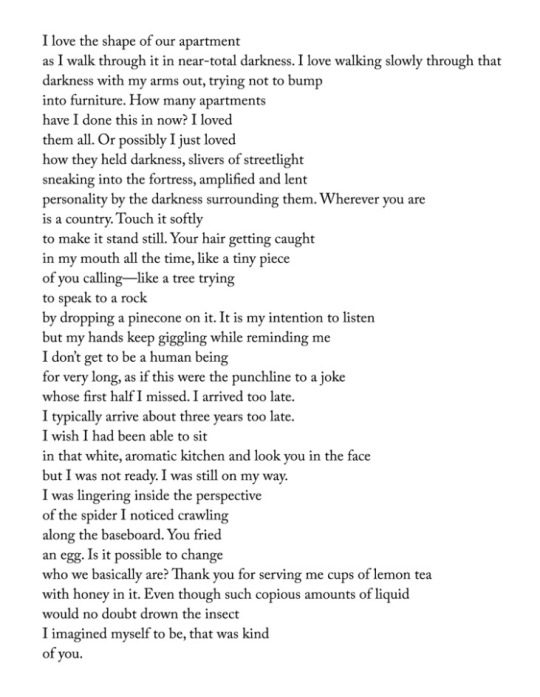
Mikko Harvey - ”Wind-related Ripple In The Wheatfield”
13 notes
·
View notes
Text
Life with Picasso by Françoise Gilot & Carlton Lake

Before I met Picasso and for some months after, my painting was figurative in an experimental way. Early in 1944 I decided that what people were referring to in the jargon as “the anecdote” was useless and I began to work in a completely nonfigurative manner. My grandmother used to come upstairs to my studio every evening to see what I had done during the day. Several months earlier I had done figurative portraits and still lifes, rather tortured in their forms, and they had shocked her. But when I began to do nonfigurative painting, she liked it immediately.
“I didn’t understand what you were doing before,” she said, “and although I don’t understand this either, I find it pleasing. I see the harmony of color and design, and since you don’t twist and torture nature, I like it better.” I told her I didn’t have the impression that it was any more pleasing than what I had been doing before. On the contrary, in my own mind the compositions I was doing now had rather dramatic intentions and they were not pleasing for me. I asked her if she found them dramatic. She said, “Not at all. I can look at those by the hour and find them restful.”
I told Pablo about that one afternoon before he settled down to painting. He laughed. “Naturally,” he said. “Nonfigurative painting is never subversive. It’s always a kind of bag into which the viewer can throw anything he wants to get rid of. You can’t impose your thought on people if there’s no relation between your painting and their visual habits. I’m not speaking of the connoisseur of painting. I mean the average person, whose visual habits are pretty conventional. He sees a tree in a certain fashion, in accordance with habits he formed in childhood. Someone who has a very cultivated vision may see a landscape of Aix as a Cézanne, a landscape of Arles as a van Gogh. But in general, people see nature in conventional fashion and they don’t want anybody tampering with it. They are willing to be shown things that resemble nothing because those things correspond to a kind of invertebrate, unformulated interior dream. But if you take a commonplace way of seeing and try to change the slightest detail in it, Everyone shouts, ‘Oh, no, it’s not possible. That’s not the portrait of my grandmother.’
“When I paint, I always try to give an image people are not expecting and, beyond that, one they reject. That’s what interests me. It’s in this sense that I mean I always try to be subversive. That is, I give a man an image of himself whose elements are collected from among the usual way of seeing things in traditional painting and then reassembled in a fashion that is unexpected and disturbing enough to make it impossible for him to escape the questions it raises.”
I told Pablo I though nobody could have done completely nonfigurative painting better than he. “I suppose so,” he said. “In those polyhedric Cubist portraits I did in tones of white and gray and ocher, beginning around 1909, there were references to natural forms, but in the early stages there were practically none. I painted them in afterwards. I call them ‘attributes.’ At that period I was doing painting for its own sake. It was really pure painting, and the composition was done as a composition.. It was only toward the end of a portrait that I brought in the attributes. At a certain moment I simply put in three or four black touches and what was around those touches became a vest.
“I suppose I use that word ‘attribute’ in the way a writer might use it rather than a painter; that is, as one speaks of a sentence with a subject, verb, and attribute. The attribute is an adjective. It serves to qualify the subject. But the verb and the subject are the whole painting, really. The attributes were the few points of reference designed to bring one back to visual reality, recognizable to anyone. And they were put in, also, to hide the pure painting behind them. I’ve never believed in doing painting for ‘the happy few.’ I’ve always felt that painting must awaken something even in the man who doesn’t ordinarily look at pictures, just as in Molière there is always something to make the very intelligent person laugh and also the person who understands nothing. In Shakespeare, too. And in my work, just as in Shakespeare, there are often burlesque things and relatively vulgar things. In that way I reach everybody. It’s not that I want to prostrate myself in front of the public, but I want to provide something for every level of thinking.” (pp. 63-65
***
Pablo shook his head. “Kahnweiler’s right,” he said. “The point is, art is something subversive. It’s something that should not be free. Art and liberty, like the fire of Prometheus, are things one must steal, to be used against the established order. Once art becomes official and open to everyone, then it becomes the new academicism. . . . If art is ever given the keys to the city, it will be because it’s been so watered down, rendered so impotent, that it’s not worth fighting for.” (p. 181)
***
“I hate that aesthetic game of the eye and the mind,” Pablo said, “played by these connoisseurs, these mandarins who ‘appreciate’ beauty. What is beauty, anyway? There’s no such thing. I never ‘appreciate,’ any more than I ‘like.’ I love or I hate.” (p. 242)
***
I asked Pablo how he would classify one of my favorite colorists—Bonnard.
“Don’t talk to me about Bonnard,” he said. “That’s not painting, what he does. He never goes beyond his own sensibility. He doesn’t know how to choose. When Bonnard paints a sky, perhaps he first paints it blue, more or less the way it looks. Then he looks a little longer and sees some mauve in it, so he adds a touch or two of mauve, just to hedge. Then he decides that maybe it’s a little pink too, so there’s no reason not to add some pink. The result is a potpourri of indecision. If he looks long enough, he winds up adding a little yellow, instead of making up his mind what color the sky really ought to be. Painting can’t be done that way. Painting isn’t a question of sensibility; it’s a matter of seizing the power, taking over from nature, not expecting her to supply you with information and good advice. That’s why I like Matisse. Matisse is always able to make an intellectual choice about colors. Whether it’s close to nature or far away, he’s always able to fill an area completely with one color, simply because it goes with the other colors on the canvas, and not because of being more or less sensitive to reality. If Matisse decided the sky should be red, it would be a real cadmium red and nothing else and it would be all right because the degree of transposition in the other colors would be at the same level. He would transpose all the other elements of the canvas into a sufficiently high color range so that the mutual relationships of those tones made possible the intensity of that first red. In that way it’s the whole color range of the composition which permits that eccentricity. Van Gogh was the first one to find the key to that tension. He wrote, ‘I’m building up to a yellow.’ You look at a wheatfield, for example; you can’t say it’s a real cadmium yellow. But once the painter takes it into his head to arrive at an arbitrary determination of color, and uses one color that is not within nature’s range but beyond it, he will then choose, for all the rest, colors and relationships which burst out of nature’s straitjacket. That’s the way he asserts his freedom from nature. And that’s what makes what he does interesting. And that’s what I hold against Bonnard. I don’t want to be moved by him. He’s not really a modern painter: he obeys nature; he doesn’t transcend it. That method of going beyond nature is actively accomplished in Matisse’s work. Bonnard is just another neo-impressionist, a decadent; the end of an old idea, not the beginning of a new one. The fact that he might have had a little more sensibility than some other painter is just one more defect as far as I’m concerned. That extra dose of sensibility makes him like things one shouldn’t like.
“Another thing I hold against Bonnard is the way he fills up the whole picture surface, to form a continuous field, with a kind of imperceptible quivering, touch by touch, centimeter by centimeter, but with a total absence of contrast. There’s never a juxtaposition of black and white, of square and circle, sharp point and curve. It’s an extremely orchestrated surface developed like an organic whole, but you never once get the big clash of the cymbals which that kind of strong contrast provides.” (pp. 247-48)
***
“I get the idea,” Paul said. “You’re the only one who has a right to be happy. You want everybody else to be unhappy, is that it?”
“Naturally,” Pablo said. “A painter shouldn’t suffer. Not in that way, at least. I suffer from people’s presence, not from their absence.” (p. 277)
***
“People have said for ages that a woman’s hips are shaped like a vase. It’s no longer poetic; it’s become a cliché. I take a vase and with it I make a woman. I take the old metaphor, make it work in the opposite direction and give it a new lease on life. It was the same way, for example, with the thoracic cage of the goat. One could say the rib cage resembles a woven wicker basket. I move from the basket back to the rib cage: from the metaphor back to reality. I make you see reality because I used the metaphor. The form of the metaphor may be worn-out or broken, but I take it, however down-at-the-heel it may have become, and use it in such an unexpected way that it arouses a new emotion in the mind of the viewer, because it momentarily disturbs his customary way of identifying and defining what he sees. It would be very easy to do these things by traditional methods, but this way I can engage the mind of the viewer in a direction he hadn’t foreseen and make him rediscover things he had forgotten.” (pp. 289-90)
2 notes
·
View notes
Text
I typically arrive three years too late. I wish I had been able to sit in that white, aromatic kitchen and look you in the face but I was not ready. I was still on my way.
“Wind-Related Ripple in the Wheatfield,” Sixth Finch (Spring 2021)
1 note
·
View note
Text
♡ Preparatory Task
𝒰𝒩𝐼𝒯 𝟪: 𝒟𝑒𝓋𝑒𝓁𝑜𝓅𝒾𝓃𝑔 𝒶𝓃 𝒶𝓇𝓉 𝒶𝓃𝒹 𝒹𝑒𝓈𝒾𝑔𝓃 𝓅𝓇𝑜𝒿𝑒𝒸𝓉
28 / 02 / 2020
♡ Select an image of an artwork or design in a museum collection that you like.

Vincent Van Gogh was always an artist I had heard about and seen a couple of times, but only until now when I was looking at the exhibits at the national art gallery online did I find that it caught my eye. A Wheatfield with Cypresses is my favorite work of his, as I love how his emphasis on shape gives an illusion of movement. Despite that this is very clearly a still painting, one of the first things that I notice is that he scene looks windy. Although it’s obvious that you cannot see wind, in this painting, we can see the effect it is having on nature as it passes. What I love most about this piece is how each stroke is curved in some way, following a pattern throughout the piece. Even though there is a lot of emphasis on circular lines, you can still effortlessly point out every different object and plant. They’re still recognizable.
The darkest point on the painting is the tall trees that span more than half of the height of the painting. When I look at this piece, I find that my eyes are always brought back towards the trees. The way they swirl with the shape of the clouds in the background gives the illusion of movement.
Connecting this back with the project though and the ideas that I have, I feel like it’s important of the illustration and concept art that I make will be able to tell a story in itself. Illustrations don’t have to have realistic silhouettes. Especially when I’m working with an idea of a man made, extremely built up scene, I can illustrate the unnatural way streets and corners are laid out. Planned out to perfection. Perfectly organised in rows. Straight lines and pointed corners will make the scene look sharper and somewhat unfriendly looking.
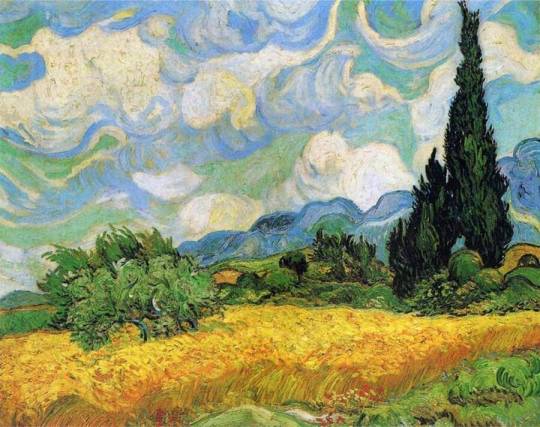
As part of our preparatory task, we also had to look at a quote that inspired us.
“Would you like an adventure now or shall we have tea first?”
- Lewis Carroll
This is a quote said by the Mad Hatter towards the main character, Alice. During her stumbling into this new world, she comes across the Hatter having tea with the hare and a mouse. She begins to question about why she is there and tries to get some answers from them, but their replies are very vague and don’t usually make much sense. What I love about Carroll’s universe is how everything feels so surreal and weird. The Wonderland that Alice is surrounded by feels almost dreamlike, because of all of the strange goings on such as using a flamingo as a crochet bat, playing cards come to life and a purple cat with a crescent moon smile.
This quote stuck out to me the most, as I like the lack of urgency in the tone of the sentence. The use of the question allows the character Alice to respond and make a decision whether to simply put off an adventure. Hatter’s character is illustrated here as insane and slightly too relaxed. We as the audience are immediately given the impression that due to his personality, he could easily be comfortable and content in a scene of chaos. This level of imaginative character writing from Lewis is so intriguing and interesting to me. How much more interesting is a slightly insane character to read about? Could I create a character with similar mad qualities? Does insanity on a character automatically make them a villain?
By comparing an adventure to something as mundane as having a cup of tea, Carroll is hinting to the reader that there is no rush to get Alice out of the dreamlike wonderland she’s in. This comparison is also very well thought out, as it easily helps an British audience to relate (as Lewis Carroll is an English Writer himself.) Within the narrative itself, Alice is following a white rabbit who is always muttering about being ‘late.’
“I’m late, I’m late! For a very important date! No time to say ‘hello, goodbye,’ I’m late, I’m late, I’m late!”
- Lewis Carroll

[Source: Disney’s 1951 Alice’s Adventures in Wonderland animated adaptation.]
This is why the earlier quote from the Mad Hatter intrigued me so much. It feels almost frustrating to the viewer that, as the main character is in a rush and time is clearly of the essence, that another character is paying no attention to urgency. This has made me think about the themes of my narrative that I could create. Maybe by making the viewer feel this level of frustration with my themes, but also enjoy the out of the ordinary world building I want to create.
Connecting back to some of our previous work, Carroll’s story could be considered to fall into the category of surrealism. Synonyms of surreal are: dreamlike, bizarre and out of the ordinary, all words that can easily describe the world down the rabbit hole that Alice had fallen into.
Artists part of the surrealism movement in the 18th century wanted to create art that went against all forms of rationalism. Their go was to free humans of the oppressive ordinary things and introduce them to what the irrational, unconscious mind is capable of seeing. Although Carroll was a writer, he was born close to the time of the surrealism movement and may also have seen a part of it. This makes me ask the question if Lewis Carroll was a surrealist himself, writing Alice’s Adventures in Wonderland as an escape for himself and his readers to enter a world different from our own.
The White Rabbit meeting Alice (triggering her adventure) = Encounter
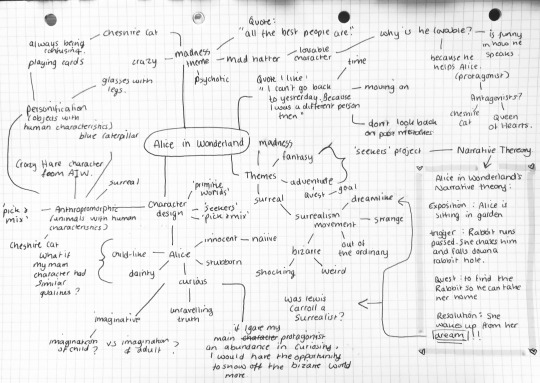
Overall, this Preparatory Task has significantly helped me to form ideas and come up with new ones. Without this, I feel as though I wouldn’t have the ideas that I do now. I now feel more comfortable with the theme of the brief and definitely feel like I could tie down some ideas and form a narrative with them. But for now I am aiming to keep my mind open to future research, so that I can still allow other aspects of my research to influence my final project, not just Alice in Wonderland.
I’ve always admired Carroll’s Alice in Wonderland, so it felt good to analyse it slightly more in-depth. The world building of his wonderland is most definitely something I want to re-visit in future.
0 notes
Text
1/27 CSI Sol’sora
Imagine, if you will, a merry band of adventurers gathered around a piece of paper, desperately trying to recall everywhere they've been in their lives and realizing, with a slow, mounting horror, that they cannot remember. Imagine then a gentle wind whipping around their faces, a soft whisper of voice from an all-knowing DM in Colorado, and then they all relax and say, "Wait, hold on, I totally know the geography of this place I've lived my whole life.
Eventually they settle on a location provided by Remi, a town called Wheatfield on the same level as Gathering. He very does not want to go back, but is a good sport about it because there's literally no other viable option. Fen wanders off outside and is promptly knocked unconscious by a rock sliding off the roof.
Most of the civilians bolted as soon as Andraki showed up and then teleported (#relatable); of the three remaining, two are in a state of catatonia, and the other is a very hardy-looking woman named Brinna, in town to have a look at the cows of Floy. She opts not to come with us, instead going to stock up on beef jerky. (Floy Jerky: The Best In The EmpireTM!)
We head outside to look for Fen and find her, unconscious, with no signs of struggle or any clues. Betha wakes her up and asks her what happened??? Was she attacked???? Did she see anything???
"They came from behind me!" Fen says, going with it. "I didn't see anything." Betha, however, has a nose for deceit, and quickly finds the offending rock. Everyone breathes a sigh of relief (except Fen, who's a little disappointed).
The party teleports to Wheatfield, which is full of wheat! The wheat is alive! And there's a tower off in the distance, which from here on out slowly begins amassing a big cloud of green badness around the top. Remi is nervous, and everyone is very concerned about Remi's nervousness. They head towards Gathering, which is still partly aflame to the west; chunks of it are slowly falling out of the sky.
They decide to walk to a monorail stop and teleport into Gathering from there, if all seems safe, and they head out. Seru mucks about with the Star Blade, and then they come across the cart of a deceased tailor. Morthred is delighted, and once he and Kaiva have pants on, so is everyone else.
A bit beyond the tailor's cart is a townhouse, which appears at first glance to be abandoned but is, in fact, not abandoned. There's a bird-man creation inside, which mimics Yannic's words and then flees when Morthred tries to make friends. Poor Morthred. He's dressed so nicely, too!
Inside, they find the B-plot of this murder mystery episode - two (uncharred) corpses laid out on the bed. Both are women, and they appear to have been strangled elsewhere and then brought to the bed. Everyone dons sunglasses and thinks very very hard, and then gives up; Betha burns the bodies, and they move out. Roll credits.
3 notes
·
View notes